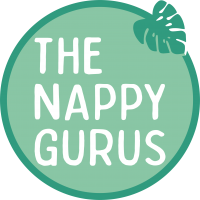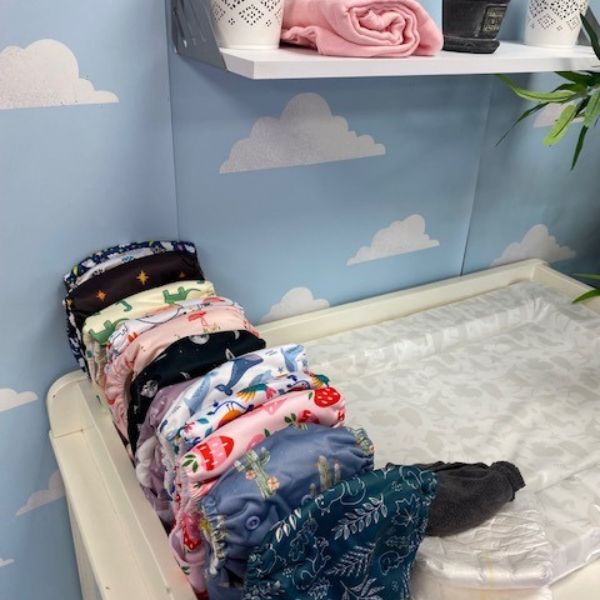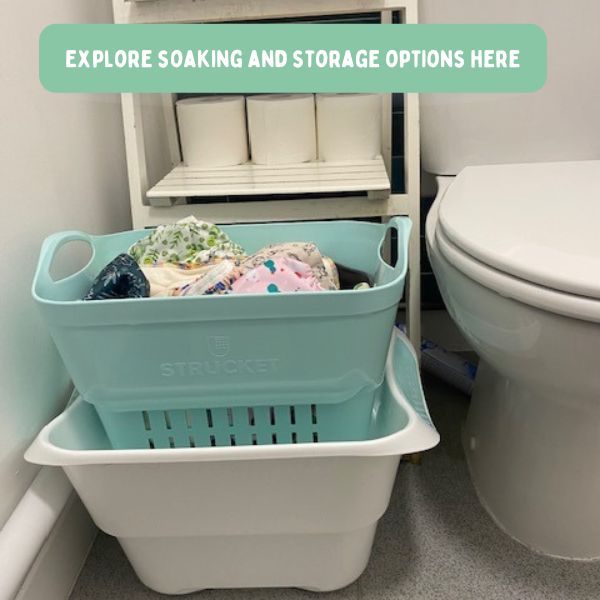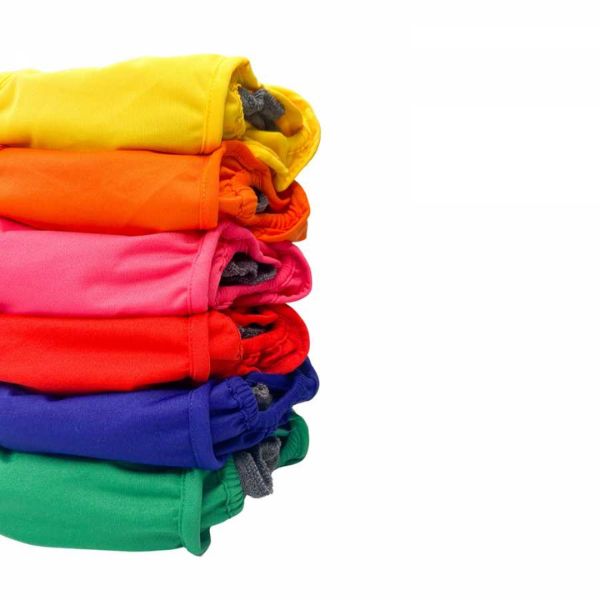How to Strip Wash & Sanitise Nappies
Cloth nappies are an eco-friendly and cost-effective option that are growing in popularity.
Once in a while you may need to give your modern cloth nappies a deeper clean - if you have bought some second-hand, if your little one has been ill or if you notice any lingering smells or rashes. It might be time to strip wash or sanitise them to be sure that your reusable nappies stay hygienic and perform their best.
We think it's important to have a blog post on strip washing as there’ can be conflicting information out there on cloth nappy groups and forums.
Some of this is based on laundry detergents and practices we don't have in the UK and might damage your nappies. Chlorine bleaching is often recommended, but this is based on American / Australia laundry bleach which is VERY different from the bleach we use here in the UK.
Using household bleach on your nappies can ruin them, especially delicate, soft bamboo. Generally, strip washing is only necessary if your cloth nappies suddenly start to smell or leak when they haven’t done previously. Occasionally teething can cause really strong acidic wee leading to ammonia build up.
What Is Strip Washing?
Strip washing is a deep-cleaning process that aims to remove detergent build-up, ammonia (from wee), bacteria (from poo) or mineral deposits that regular washing might not fully remove.
With a solid washing routine you shouldn't need to sanitise for bacteria and ammonia BUT it happens sometimes, maybe when someone else meddled with your washing or when nappies get forgotten about in a nursery bag, and after a tummy bug or yeast infection it is worth ensuring you won't have anything harmful left on your diapers.
Over time, residue from detergent or hard water can cause your cloth nappies, inserts and nappy liners to lose absorbency, feel stiff, or smell unpleasant.
What Is Sanitising?
Sanitising and strip washing are interchangeable terms. You may find advice to soak heavily stained items, this is often unnecessary as the steps below to strip wash will be enough.
Typically, it involves a short soak of your nappies in a nappy bucket in a sanitising solution or using a specific cycle in your washing machine. DO NOT soak for more than an hour or two - definitely not overnight, there is no need and you risk degrading the fabrics and allowing ammonia to seep into everything.
Day to day we recommend dirty cloth nappies are stored in a dry pail - without water - in a nappy bucket, hanging wet bag or airy strucket basket.
How Do I Know If I Need to Strip Wash My Nappies?
You may need to strip wash or sanitise your cloth nappies if you notice any of the following signs:
- Persistent odours that linger after washing or resurface when your little one wees.
- Reduced absorbency, leading to leaks.
- Nappy rash or skin irritation after use.
- You’ve purchased second-hand nappies and want to deep-clean them before use.
- Nappies feel stiff or have visible detergent residue.
How to Strip Wash Cloth Nappies
According to the Nappy Alliance (UK Reusable Nappy Manufacturers), here's how to strip wash reusable nappies:
- Cool rinse, or quick wash cycle, no detergent
- Hot wash, long cycle with full dose of detergent
- Hot wash, full length no detergent
- Extra rinse again if necessary
1. Rinse or pre wash
Before starting the strip wash process, run a rinse or pre-wash cycle in your washing machine. Keep this cool and with no detergent. My rinse cycle is 18 minutes, don't spin after this as you want the nappies to be very wet. Modern washing machines are economical with water so we need this extra moisture.
2. Hot wash
Check the guidelines of your washable nappies, most nappies are recommended to wash between 40 - 60 degrees, you won't need as hot as a 90 degree wash - this will melt any waterproof layers in nappy wraps. Check manufacturers guidelines though as many limit you to 40 degrees including Cheeky nappies.
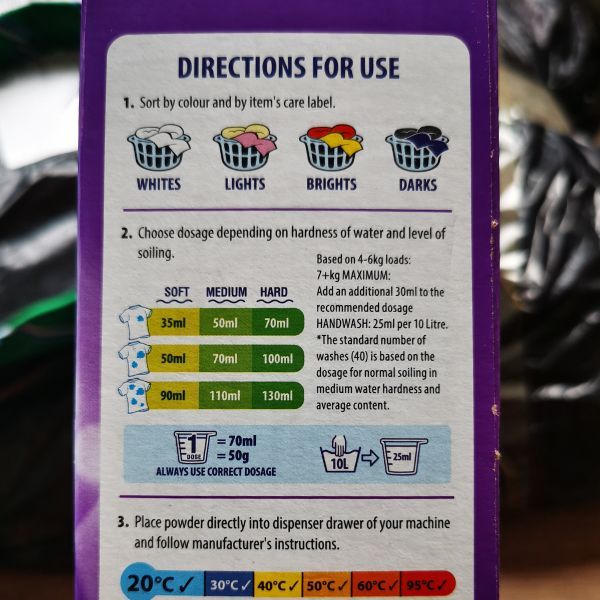
Select the longest wash cycle and the correct dose of laundry detergent for heavily soiled items and match your load size.
We strongly recommend using bio powder detergent. We are the only country with a non bio option and the link to irritation to babies skin has been disproved. The enzymes in the powder will 'eat' any bacteria. I have used bio for my whole adult life and haven't seen it eat any clothing (or nappies) yet.
Do not use fabric softeners on any absorbent materials as it will build up a coating and stop absorption.
3. Hot wash - again
Same again, this time with no detergent - watch to see if you have any suds left towards the end.
4. Extra rinse again if necessary
This will only be needed if you could still see suds at the end of the 2nd wash cycle.
5. Dry Nappies
Dry the nappies as you normally would—either on a washing line in sunlight or in a tumble dryer on low if the material allows. Both can help - tumble driers will further kill bacteria and the UV light of the sun can bleach out stains.
How to Sanitise Cloth Nappies
If you want to treat a stain you can make a paste with an oxygen based stain remover - napisan / vanish oxi action / Bio D or a stain soap bar and leave to soak for a short while then drain and wash following the steps above.
How Often Should I Strip Wash Nappies?
You shouldn’t need to strip wash your nappies very often. Strip washing is only required when nappies become less effective, develop odours, or show signs of build-up.
I LOVED my cloth nappies and in the three years I used them, apart from when I bought pre-loved cloth nappies, I only strip washed them twice - once after a stomach bug and then once more when I got them ready to sell!
Will Strip Washing Damage My Nappies?
Strip washing won’t damage your nappies. However, overdoing it or using harsh chemicals can weaken fabrics or elastic over time. Always follow the manufacturer’s care instructions to keep your nappies in good condition.
Closing Thoughts
By following the correct methods, you can keep your nappies in excellent condition and your little one comfortable and rash-free. If you worry your cloth diapers are not getting clean enough you can add some laundry disinfectant once a week and make sure you run a 70 degree maintenance wash on empty once a month to keep your machine clean and clear any detergent residue.
You can contact us directly for advice, the team chat pee, poo and periods all day long and are happy to help! We’d also love to hear your experiences or answer any questions in the comments!
You can read more of our blogs for helpful tips and guides:
Whats the difference between nappy inserts and boosters?
About the Author: Kirstin on our customer services team loves spending her days helping customers with their reusable period product needs and advising cloth nappy using families. Kirstin lives with her three teenagers and loves walking, cycling and sea swimming year round in our beautiful bay.She is excited to share her extensive knowledge and enthusiasm for all things reusable, helping a new generation of parents navigate eco-friendly choices for their children.
